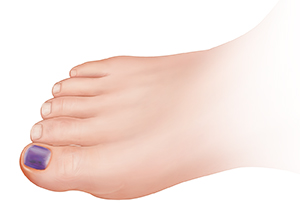Understanding Black-and-Blue Nails
Understanding Black-and-Blue Nails

Symptoms
The big toe is most often affected. Bruised, broken blood vessels cause the black-and-blue colors under the nail. If the condition is the result of a sudden injury, pain may be severe.
Evaluation
Your healthcare provider will talk with you about your symptoms and physical activities. He or she may press the area at the end of the toe to determine the extent of pain. Your toe and foot will be examined for any signs of infection. If a fracture or a bone spur is suspected, X-rays may be needed. If small black spots are present under the nail, other problems may need to be ruled out.
Treatment
If pain is severe, the nail may be removed, or a hole may be drilled in the nail to allow drainage of the fluid underneath. This relieves the pressure. A local anesthetic may be used. Pain may also be relieved with prescription medicines, or by soaking or icing the area. If pain is not severe, you may not need treatment. The nail can be thinned or left alone to fall off. A new nail should grow to replace it.
Prevention
Many nail problems can be prevented by wearing the right shoes and trimming your nails properly. To help avoid infection, keep your feet clean and dry. If you have diabetes, talk with your healthcare provider before doing any foot self-care.
The right shoes: Get your feet measured (your size may change as you age). Wear shoes that are supportive and roomy enough for your toes to wiggle. Look for shoes made of natural materials such as leather, which allow your feet to breathe.
Proper trimming: To avoid problems, trim your toenails straight across without cutting down into the corners. If you can’t trim your own nails, ask a healthcare provider to do so for you.
Updated:
March 21, 2017
Reviewed By:
Joseph, Thomas N., MD,Moloney, Amanda Jane (Johns), PA-C, MPAS, BBA